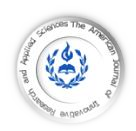
GENERAL INFORMATION
| HOME | ABOUT US | ARCHIVE | AIMS AND SCOP | AUTHORS | REVIEW | SUMIBMIT MANUSCRIPT | EDITORIAL BOARED | PUBLICATION FEE |

| HOME || ABOUT US || ARCHIVES || AIMS AND SCOP || AUTHORS || REVIEW|| SUBMIT MANUSCRIPT || EDITORIAL BOARD |

| Info-AJIRAS-® Journal ISSN 2429-5396 (Online) / Reference CIF/15/0289M |
American Journal of Innovative Research & Applied Sciences

|
American Journal of innovative
Research & Applied Sciences
Research & Applied Sciences
ISSN 2429-5396 (Online)
OCLC Number: 920041286
OCLC Number: 920041286

Authors Contact
*Correspondant author and authors Copyright © 2023:
| Bleu Gomé Michel 1* | Ackah Jacques Auguste Alfred Bognan 2 | Kahou Bi Gohi Parfait 2 | Dabo Vouzo Philippe Aziz 2 | Néné Bi Sémi Anthelme 3 | et | Traoré Flavien 3 |
Affiliation.
1. Laboratory of Biodiversity and Tropical Ecology | Environment Training and Research Unit | Jean Lorougnon Guédé University | Daloa, Côte d’Ivoire |
2. Laboratory of Agrovalorisation | Agroforestry Training and Research Unit | Jean Lorougnon Guédé University | Daloa, Côte d’Ivoire |
3. Laboratoty of Biology and Health | Biosciences Training and Research Unit | Félix Houphouët-Boigny University | Abidjan, Côte d’Ivoire |
This article is made freely available as part of this journal's Open Access: ID | Michel-Ref1-16ajiras271222 |
*Correspondant author and authors Copyright © 2023:
| Bleu Gomé Michel 1* | Ackah Jacques Auguste Alfred Bognan 2 | Kahou Bi Gohi Parfait 2 | Dabo Vouzo Philippe Aziz 2 | Néné Bi Sémi Anthelme 3 | et | Traoré Flavien 3 |
Affiliation.
1. Laboratory of Biodiversity and Tropical Ecology | Environment Training and Research Unit | Jean Lorougnon Guédé University | Daloa, Côte d’Ivoire |
2. Laboratory of Agrovalorisation | Agroforestry Training and Research Unit | Jean Lorougnon Guédé University | Daloa, Côte d’Ivoire |
3. Laboratoty of Biology and Health | Biosciences Training and Research Unit | Félix Houphouët-Boigny University | Abidjan, Côte d’Ivoire |
This article is made freely available as part of this journal's Open Access: ID | Michel-Ref1-16ajiras271222 |


RESUME
Contexte : Le diabète représente de nos jours un problème majeur de santé publique dans le monde. Vu le coût élevé de la prise en charge dans les hôpitaux modernes en Afrique et les effets secondaires qui l’accompagnent, la valorisation des plantes traditionnelles utilisées par les populations africaines pour traiter cette maladie devient une priorité. Objectif : Ce travail a eu pour objectif de réaliser un screening phytochimique de Annona muricata et d’évaluer ses propriétés antihyperglycémiantes chez la souris albinos Swiss. Méthodes : Le screening phytochimique a été réalisé à partir de l’extrait aqueux d’écorce de tige de A. muricata (EAAM). Il a consisté à caractériser certains métabolites secondaires contenus dans cet extrait à l’aide de réactions chimiques standards. Ensuite, une étude de la toxicité orale aigüe a été réalisée en constituant 2 lots de 5 souris femelles. Le lot 1 (témoin) a reçu de l’eau distillée et le lot 2 a été traité avec une dose unique de 5000 mg/kg de poids corporel (PC) de l’EAAM. Les animaux ont été observés régulièrement pendant 14 jours après le traitement pour des signes cliniques de toxicité. L’effet antihyperglycémiant de A. muricata a été étudié en formant 4 lots de 6 souris (3 mâles, 3 femelles) qui ont été prétraités avec l’eau distillée (lot 1, témoin), 5 mg/kg de PC de glibenclamide (lot 2), 100 mg/kg de PC (lot 3) et 200 mg/kg de PC (lot 4) de EAAM avant de leur administrer 5 g/kg de PC de glucose. La glycémie des animaux a été mesurée juste avant les prétraitements puis 30 min, 1, 2, 3 et 4 heures après l’administration du glucose. Résultats : L’EAAM contient des polyterpènes, des stérols, des composés phénoliques, des flavonoïdes, des tanins catéchiques, des quinones, des alcaloïdes et des saponosides. Cet extrait n’est pas toxique puisque l’administration de la dose de 5000 mg/kg de PC n’a provoqué aucune mortalité ni anomalie comportementale chez les souris durant les 14 jours d’observation. En outre, EAAM induit chez les animaux une baisse hautement significative de la glycémie aux doses de 100 et 200 mg/kg de PC en comparaison à celle des témoins de la 1ère à la 4ème heure après l’administration du glucose. Cette baisse est comparable à l’effet du glibenclamide. Conclusion : A. muricata est riche en métabolites secondaires recherchés et n’est pas toxique par voie orale. Cette plante possède des propriétés antihyperglycémiantes semblables à celle du glibenclamide, une molécule antidiabétique. Des études plus approfondies sont nécessaires en vue d’élucider le mécanisme d’action des principes actifs de cet extrait.
Mots clés : Annona muricata, diabète, antihyperglycémiant, glycémie.
ABSTRACT
Background: Diabetes is nowadays a major public health problem in the world. Given the high cost of care in modern hospitals in Africa and the side effects that accompany it, the promotion of traditional plants used by African populations to treat this disease becomes a priority. Objective: This work aimed to perform a phytochemical screening of Annona muricata and to evaluate its antihyperglycemic properties in Swiss albino mice. Methods: The phytochemical screening was carried out using the aqueous extract of stem bark of A. muricata (EAAM). It consisted in characterizing certain secondary metabolites contained in this extract using standard chemical reactions. Then, an acute oral toxicity study was carried out by constituting 2 groups of 5 female mice. Group 1 (control) received distilled water and group 2 was treated with a single dose of 5000 mg/kg body weight (BW) of EAAM. Animals were observed regularly for 14 days after treatment for clinical signs of toxicity. The antihyperglycaemic effect of A. muricata was studied by constituting 4 groups of 6 mice (3 males, 3 females) which were pretreated with distilled water (group 1, control), 5 mg/kg BW of glibenclamide (group 2), 100 mg/kg BW (group 3) and 200 mg/kg BW (group 4) of EAAM before administering to them 5 g/kg BW of glucose. The glycaemia of the animals was measured just before the pretreatments then 30 min, 1, 2, 3 and 4 hours after glucose administration. Results: EAAM contained polyterpenes, sterols, phenolic compounds, flavonoids, catechic tannins, quinones, alkaloids and saponosides. This extract was not toxic since the administration of the dose of 5000 mg/kg BW did not cause any mortality or behavioral abnormality in mice during the 14 days of observation. In addition, EAAM induced in animals a highly significant decrease in glycaemia at doses of 100 and 200 mg/kg BW compared to that of controls from the 1st to the 4th hour after the administration of glucose. This decrease was comparable to the effect of glibenclamide. Conclusion: A. muricata is rich in desired secondary metabolites and is not toxic by the oral route. This plant possessed antihyperglycemic properties similar to that of glibenclamide, an antidiabetic molecule. Further studies are needed to elucidate the mechanism of action of the active ingredients of this extract.
Key words: Annona muricata, diabetes, antihyperglycemic, glycaemia.
Contexte : Le diabète représente de nos jours un problème majeur de santé publique dans le monde. Vu le coût élevé de la prise en charge dans les hôpitaux modernes en Afrique et les effets secondaires qui l’accompagnent, la valorisation des plantes traditionnelles utilisées par les populations africaines pour traiter cette maladie devient une priorité. Objectif : Ce travail a eu pour objectif de réaliser un screening phytochimique de Annona muricata et d’évaluer ses propriétés antihyperglycémiantes chez la souris albinos Swiss. Méthodes : Le screening phytochimique a été réalisé à partir de l’extrait aqueux d’écorce de tige de A. muricata (EAAM). Il a consisté à caractériser certains métabolites secondaires contenus dans cet extrait à l’aide de réactions chimiques standards. Ensuite, une étude de la toxicité orale aigüe a été réalisée en constituant 2 lots de 5 souris femelles. Le lot 1 (témoin) a reçu de l’eau distillée et le lot 2 a été traité avec une dose unique de 5000 mg/kg de poids corporel (PC) de l’EAAM. Les animaux ont été observés régulièrement pendant 14 jours après le traitement pour des signes cliniques de toxicité. L’effet antihyperglycémiant de A. muricata a été étudié en formant 4 lots de 6 souris (3 mâles, 3 femelles) qui ont été prétraités avec l’eau distillée (lot 1, témoin), 5 mg/kg de PC de glibenclamide (lot 2), 100 mg/kg de PC (lot 3) et 200 mg/kg de PC (lot 4) de EAAM avant de leur administrer 5 g/kg de PC de glucose. La glycémie des animaux a été mesurée juste avant les prétraitements puis 30 min, 1, 2, 3 et 4 heures après l’administration du glucose. Résultats : L’EAAM contient des polyterpènes, des stérols, des composés phénoliques, des flavonoïdes, des tanins catéchiques, des quinones, des alcaloïdes et des saponosides. Cet extrait n’est pas toxique puisque l’administration de la dose de 5000 mg/kg de PC n’a provoqué aucune mortalité ni anomalie comportementale chez les souris durant les 14 jours d’observation. En outre, EAAM induit chez les animaux une baisse hautement significative de la glycémie aux doses de 100 et 200 mg/kg de PC en comparaison à celle des témoins de la 1ère à la 4ème heure après l’administration du glucose. Cette baisse est comparable à l’effet du glibenclamide. Conclusion : A. muricata est riche en métabolites secondaires recherchés et n’est pas toxique par voie orale. Cette plante possède des propriétés antihyperglycémiantes semblables à celle du glibenclamide, une molécule antidiabétique. Des études plus approfondies sont nécessaires en vue d’élucider le mécanisme d’action des principes actifs de cet extrait.
Mots clés : Annona muricata, diabète, antihyperglycémiant, glycémie.
ABSTRACT
Background: Diabetes is nowadays a major public health problem in the world. Given the high cost of care in modern hospitals in Africa and the side effects that accompany it, the promotion of traditional plants used by African populations to treat this disease becomes a priority. Objective: This work aimed to perform a phytochemical screening of Annona muricata and to evaluate its antihyperglycemic properties in Swiss albino mice. Methods: The phytochemical screening was carried out using the aqueous extract of stem bark of A. muricata (EAAM). It consisted in characterizing certain secondary metabolites contained in this extract using standard chemical reactions. Then, an acute oral toxicity study was carried out by constituting 2 groups of 5 female mice. Group 1 (control) received distilled water and group 2 was treated with a single dose of 5000 mg/kg body weight (BW) of EAAM. Animals were observed regularly for 14 days after treatment for clinical signs of toxicity. The antihyperglycaemic effect of A. muricata was studied by constituting 4 groups of 6 mice (3 males, 3 females) which were pretreated with distilled water (group 1, control), 5 mg/kg BW of glibenclamide (group 2), 100 mg/kg BW (group 3) and 200 mg/kg BW (group 4) of EAAM before administering to them 5 g/kg BW of glucose. The glycaemia of the animals was measured just before the pretreatments then 30 min, 1, 2, 3 and 4 hours after glucose administration. Results: EAAM contained polyterpenes, sterols, phenolic compounds, flavonoids, catechic tannins, quinones, alkaloids and saponosides. This extract was not toxic since the administration of the dose of 5000 mg/kg BW did not cause any mortality or behavioral abnormality in mice during the 14 days of observation. In addition, EAAM induced in animals a highly significant decrease in glycaemia at doses of 100 and 200 mg/kg BW compared to that of controls from the 1st to the 4th hour after the administration of glucose. This decrease was comparable to the effect of glibenclamide. Conclusion: A. muricata is rich in desired secondary metabolites and is not toxic by the oral route. This plant possessed antihyperglycemic properties similar to that of glibenclamide, an antidiabetic molecule. Further studies are needed to elucidate the mechanism of action of the active ingredients of this extract.
Key words: Annona muricata, diabetes, antihyperglycemic, glycaemia.

| ISSN: 2429-5396 (e) | https://www.american-jiras.com | |
| Web Site Form: v 0.1.05 | JF 22 Cours, Wellington le Clairval, Lillebonne | France |
| Web Site Form: v 0.1.05 | JF 22 Cours, Wellington le Clairval, Lillebonne | France |
| FEBRUARY | VOLUME 16 | ISSUE N° 2 | 2023 |
| ARTICLES | Am. J. innov. res. appl. sci. Volume 16, Issue - 2 Pages 69-76 (February 2023)
SCREENING PHYTOCHIMIQUE ET PROPRIÉTÉS ANTIHYPERGLYCÉMIANTES DE L’EXTRAIT AQUEUX DE L'ÉCORCE DE TIGE DE Annona Muricata L. (ANNONACEAE)
PHYTOCHEMICAL SCREENING AND ANTIHYPERGLYCAEMIC PROPERTIES OF THE AQUEOUS EXTRACT OF THE STEM BARK OF Annona Muricata L. (ANNONACEAE)
| Bleu Gomé Michel 1* | Ackah Jacques Auguste Alfred Bognan 2 | Kahou Bi Gohi Parfait 2 | Dabo Vouzo Philippe Aziz 2 | Néné Bi Sémi Anthelme 3 | et | Traoré Flavien 3 |. Am. J. innov. res. appl. sci. 2023; 16(2):69-76.
| PDF FULL TEXT | | XML FILE | | | Abstract and Author Contact |
PHYTOCHEMICAL SCREENING AND ANTIHYPERGLYCAEMIC PROPERTIES OF THE AQUEOUS EXTRACT OF THE STEM BARK OF Annona Muricata L. (ANNONACEAE)
| Bleu Gomé Michel 1* | Ackah Jacques Auguste Alfred Bognan 2 | Kahou Bi Gohi Parfait 2 | Dabo Vouzo Philippe Aziz 2 | Néné Bi Sémi Anthelme 3 | et | Traoré Flavien 3 |. Am. J. innov. res. appl. sci. 2023; 16(2):69-76.
| PDF FULL TEXT | | XML FILE | | | Abstract and Author Contact |